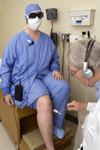Signs and symptoms versus nerve conduction studies to diagnose diabetic sensorimotor polyneuropathy: Cl vs. NPhys trial
- PMID: 20658599
- PMCID: PMC2956592
- DOI: 10.1002/mus.21661
Signs and symptoms versus nerve conduction studies to diagnose diabetic sensorimotor polyneuropathy: Cl vs. NPhys trial
Abstract
The purpose was to test whether physicians can validly and reproducibly diagnose diabetic sensorimotor polyneuropathy (DSPN). Twelve physicians assessed 24 patients with diabetes mellitus (DM) on consecutive days (576 examinations) with physical features and voice disguised. Results were compared to gold standard 75% group diagnosis (dx) and a nerve conduction score (Sigma5 NC nds). Masking of patients was achieved. Reproducibility measured by the kappa coefficient and compared to Sigma5 NC nd varied considerably among physicians: median and ranges: signs 0.8 (0.32-1.0); symptoms 0.79 (0.36-1.0), and diagnoses 0.47 (0.33-0.84), both low and high scores indicating poor performance. There was substantial agreement between 75% group dx and confirmed NC abnormality (abn). As compared to Sigma5 NC, individual physicians' clinical dx was excessively variable and frequently inaccurate. Study physician dx from signs and symptoms were excessively variable, often overestimating DSPN. Specific approaches to improving clinical proficiency should be tested.
Figures
Similar articles
-
Monotonicity of nerve tests in diabetes: subclinical nerve dysfunction precedes diagnosis of polyneuropathy.Diabetes Care. 2005 Sep;28(9):2192-200. doi: 10.2337/diacare.28.9.2192. Diabetes Care. 2005. PMID: 16123489
-
Composite nerve conduction scores and signs for diagnosis and somatic staging of diabetic polyneuropathy: Mid North American ethnic cohort survey.Muscle Nerve. 2023 Jul;68(1):29-38. doi: 10.1002/mus.27793. Epub 2023 Mar 1. Muscle Nerve. 2023. PMID: 36734298 Free PMC article.
-
Validation of a novel point-of-care nerve conduction device for the detection of diabetic sensorimotor polyneuropathy.Diabetes Care. 2006 Sep;29(9):2023-7. doi: 10.2337/dc08-0500. Diabetes Care. 2006. PMID: 16936147
-
Diabetic polyneuropathies: update on research definition, diagnostic criteria and estimation of severity.Diabetes Metab Res Rev. 2011 Oct;27(7):620-8. doi: 10.1002/dmrr.1226. Diabetes Metab Res Rev. 2011. PMID: 21695763 Review.
-
[Diagnosis and treatment of polyneuropathy: what can the family doctor do?].MMW Fortschr Med. 2003 May 26;145 Suppl 2:81-5. MMW Fortschr Med. 2003. PMID: 14579490 Review. German.
Cited by
-
Neuropathy symptom and change: Inotersen treatment of hereditary transthyretin amyloidosis.Muscle Nerve. 2020 Oct;62(4):509-515. doi: 10.1002/mus.27023. Epub 2020 Aug 7. Muscle Nerve. 2020. PMID: 32654156 Free PMC article. Clinical Trial.
-
Mechanisms and management of diabetic painful distal symmetrical polyneuropathy.Diabetes Care. 2013 Sep;36(9):2456-65. doi: 10.2337/dc12-1964. Diabetes Care. 2013. PMID: 23970715 Free PMC article. Review.
-
Challenges of neuropathic pain: focus on diabetic neuropathy.J Neural Transm (Vienna). 2020 Apr;127(4):589-624. doi: 10.1007/s00702-020-02145-7. Epub 2020 Feb 8. J Neural Transm (Vienna). 2020. PMID: 32036431 Free PMC article. Review.
-
Timed Vibration Sense and Joint Position Sense Testing in the Diagnosis of Distal Sensory Polyneuropathy.J Neurosci Rural Pract. 2019 Apr-Jun;10(2):273-277. doi: 10.4103/jnrp.jnrp_241_18. J Neurosci Rural Pract. 2019. PMID: 31001017 Free PMC article.
-
Declining Skeletal Muscle Function in Diabetic Peripheral Neuropathy.Clin Ther. 2017 Jun;39(6):1085-1103. doi: 10.1016/j.clinthera.2017.05.001. Epub 2017 May 30. Clin Ther. 2017. PMID: 28571613 Free PMC article. Review.
References
-
- Llewelyn JG, Tomlinson DR, Thomas PK. Diabetic Neuropathies. In: Dyck PJ, Thomas PK, editors. Peripheral Neuropathy. Fourth Edition. Philadelphia: Elsevier; 2005. pp. 1951–1992.
-
- Dyck PJ. Detection, characterization, and staging of polyneuropathy: assessed in diabetics. Muscle Nerve. 1988;11:21–32. - PubMed
-
- Dyck PJ, Norell JE, Tritschler H, Schuette K, Samigullin R, Ziegler D, et al. Challenges in design of multicenter trials: end points assessed longitudinally for change and monotonicity. Diabetes Care. 2007;30:2619–2625. - PubMed
-
- Mulder DW, Lambert EH, Bastron JA, Sprague RG. The neuropathies associated with diabetes mellitus: a clinical and electromyographic study of 103 unselected diabetic patients. Neurology. 1961;11:275–284. - PubMed
Publication types
MeSH terms
Grants and funding
LinkOut - more resources
Full Text Sources
Other Literature Sources
Medical
Research Materials


